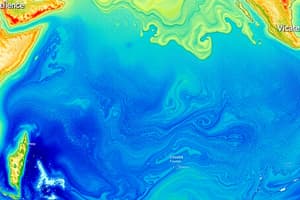Podcast
Questions and Answers
Match the components that power the global ocean current system:
Match the components that power the global ocean current system:
Salt = Some sunlight
Match the time period when the German Naval Observatory conducted the ocean-tracking experiment:
Match the time period when the German Naval Observatory conducted the ocean-tracking experiment:
1864-1932 = 1800s
Match the entity that released the message in a bottle in the Indian Ocean:
Match the entity that released the message in a bottle in the Indian Ocean:
German Naval Observatory = Shipwrecked sailor
Match the reason why the message in a bottle was released:
Match the reason why the message in a bottle was released:
Match the year when the message in a bottle was found in Australia:
Match the year when the message in a bottle was found in Australia:
Match the impact of climate change on the global ocean current system:
Match the impact of climate change on the global ocean current system:
Match the following terms with their descriptions:
Match the following terms with their descriptions:
Match the following ocean characteristics with their descriptions:
Match the following ocean characteristics with their descriptions:
Match the following ocean current factors with their descriptions:
Match the following ocean current factors with their descriptions:
Match the following ocean features with their descriptions:
Match the following ocean features with their descriptions:
Match the following terms with their descriptions:
Match the following terms with their descriptions:
Match the following ocean characteristics with their descriptions:
Match the following ocean characteristics with their descriptions:
Flashcards are hidden until you start studying




